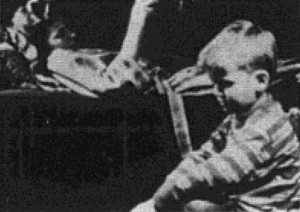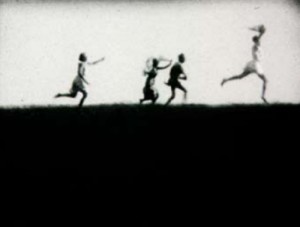
"Mother is tired and catnaps while junior is at play. Soon junior takes his teddy bear and goes exploring the park, highway, and railroad. There are automobiles and trains to spark anxious moments. When Mother awakens, the young man has returned from his venture. A dream, perhaps" PSA Journal, Nov. 1960, 41.
"Film opens with a shot of a camera and projector. Following scenes include family footage of two girls dancing in a garden; shots of a birdbox, beehive and female beekeeper; snowy street scenes; a child playing with a lamb; women participating in an outdoor gymnastic display and brief footage of a cricket match at Ashley." (NWFA Online Database)
"Interior shots of a woman with a young child sat on her knee. Cuts to a shot of a woman and child playing in a field. The child sits on an adult's bicycle and the woman pushes it across the field towards the camera. A dog follows on behind" (NWFA Online Database).
"Family footage shot in the garden of a house situated on The Beeches in West Didsbury; April 1925. Includes various scenes of a baby and child, sitting in a pram and playing with their nanny" (NWFA Online Database).
"Children playing in the Behrens family garden. Includes shots of two little girls sitting on a small wooden horse and a toddler wearing a knotted handkerchief on its head" (NWFA Online Database).
"Children Grow Up, photographed by Charles J. Carbonaro, ACL, and produced by The Religious Motion Picture Foundation, is one of the best examples of effectively handling amateur actors in a story telling film yet made. This three reel film was avowedly produced to point a moral in parent and child relationships and, as such, may be classed as social propaganda, a function in which it succeeds admirably. Yet the story it tells seems genuine and is of general audience interest. The film is carefully cut so that the action is logical and smoothly paced. Mr. Carbonaro is particularly to be congratulated for his handling of the difficult technique of parallel action, which occurs as the development of the children of two separate families takes place. Both streams of interest merge into one in a well planned, dramatic climax. The story is told entirely with the aid of amateur actors. Interior shots are in the majority and, for these, no special sets were built, the furnishings of the ordinary home being used. The lighting and exposure under these conditions are excellent throughout." Movie Makers, Dec. 1935, 534.
"Documentary: Depicts lives of children in the Belgian Congo and French Cameroon." National Archives.

"Combines ancestral memory with reincarnation when the main character falls asleep, sees nymphs dancing in the same landscape hundreds of years in the past, and confronts his previous incarnation herding sheep and wearing fur." UC Berkeley Library.
"Bringing Kodacolor indoors was the task E. M. Barnard, ACL, set for himself in Christmas 1933, and the result is a 400 foot reel of very charming Christmas studies. One of the few attempts at a complete personal story in color, this picture presents a well photographed and adequately planned film of the youngsters' enjoyment of the holiday. Exposure for interior Kodacolor seems to be no problem to Mr. Barnard, for the majority of his scenes have perfect color rendition as well as very effective and interesting lighting. Some of the studies of his small daughter have an appealing loveliness that is impossible to get in black and white, for they present the very delicate flesh tones with perfect faith as well as the colors of costumes and incidental Christmas background. This film marks a new step in personal indoor filming and leads the way to more extensive use of the color medium by artificial light." Movie Makers, Dec. 1934, 546.
"Among the Ten Best, A Christmas at Home, by Edmund Zacher, II. ACL. is a lovely mine of bright gems which glows with all the warmth and color so surely associated with this festive season. Although essentially of slow pace, the film never once loses appeal, as it presents with loving and tender enthusiasm the countless minutiae of beauty which blend into the charm of Christmas at home. Mr. Zacher's color photography, predominantly interior, is crisp and delicately beautiful, while his sensitive selection of material and cunning choice of angles are an unfailing delight. Multiple exposures of such charm and flawless craftsmanship as almost to defy detection adorn his opening and closing sequences, and the entire production is pleasantly scored with appropriate music and sound effects. More than once a previous winner in these annual selections, Mr. Zacher seems not yet to have reached the full measure of his fine skill with camera and film." Movie Makers, Dec. 1935, 534.
Total Pages: 19